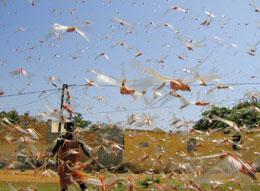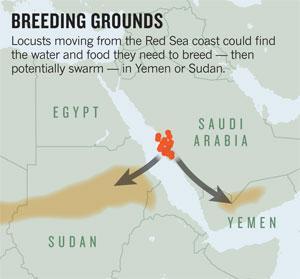Digital wellbeing should be a public health priority for the Arab region
21 October 2025
Published online 30 June 2011

Diplomats and analysts aren't the only ones preoccupied by the armed clashes and demonstrations in Yemen. Scientists and agricultural officials have been keeping watch on the turbulent nation as well, hoping that a lack of rainfall will accomplish what the Yemeni government probably cannot: prevent a large-scale outbreak of the fearsome desert locust (Schistocerca gregaria).
The grasshoppers have already infested Saudi Arabia's Red Sea coast. Special locust squads, guided by satellite data to the breeding grounds, have sprayed more than 90,000 hectares since January. But international agricultural officials worry that some of the grasshoppers might escape to Yemen, where they often breed. There they could potentially take advantage of the country's weakened defences and multiply into the kind of swarm that has previously ravaged large swathes of Africa and the Middle East.
The Food and Agriculture Organization of the United Nations (FAO) in Rome issued a locust outbreak warning earlier this month, saying that political instability could prevent effective control of the locusts in the interior of Yemen. "We are following the situation, but until now we haven't been able to move into those areas owing to security problems," confirms Fuad Bahakim, director of Yemen's locust programme in Sana'a. Response teams have the resources they need, he says, but journeying across the country remains risky.
Locusts lay their eggs in moist, sandy soils and flourish when the desert blooms. If the breeding gets out of control, the normally brown adults abandon their solitary ways, turn yellow and become 'gregarious'. This is the dangerous phase, in which the locusts follow the wind and devour everything in sight. Such swarms threaten agricultural production in some 50 countries across the Middle East, northern Africa and the Indian subcontinent.
The last such outbreak occurred in 2004, when locust swarms from the Sahel darkened the skies over Cairo and devastated crops across Africa. The outbreak, which took a year to control, cut cereal production by some 80% in the affected areas of Burkina Faso and by at least 90% in those in Mali and Mauritania.
The good news this year, says Keith Cressman, senior locust forecasting officer with the FAO, is that the danger of an uncontrolled outbreak in Yemen is declining as the country heads into its dry season. So far, the breeding grounds there have seen little precipitation, and the kind of rainy spell that would significantly boost the locust population is becoming less likely. "If we can get through these next couple of weeks, then we are probably okay," he says.

However, that does not mean the danger would be over, Cressman warns. Wind could still carry the locusts across the Red Sea and into northern Sudan (see 'Breeding grounds'), where the wet season typically runs from July until September. Although fighting continues between government troops and militias in the Darfur region, Cressman says that agricultural officials there should be able to control locusts throughout most of northern Sudan.
Locust controllers can call on increasingly sophisticated tools, including regional weather forecasting and satellite imagery for tracking rainfall and vegetation as well as hand-held global-positioning-system devices to monitor progress in the field. Orbiting sensors can identify pockets of vegetation hidden at the base of sand dunes and along ephemeral streams, says Pietro Ceccato, a remote-sensing scientist at the International Research Institute for Climate and Society who works with the FAO's locust team at Columbia University's Lamont-Doherty Earth Observatory in New York.
Ceccato, who developed the current method for detecting vegetation using NASA's Moderate Resolution Imaging Spectroradiometer sensor and similar platforms, says that the FAO is now working with field teams in Algeria to test the sensitivity of their methods. The aim is to spot pockets of plant growth by combining a measure of the 'greenness' of an area with infrared data that reveal water content. "We want to know how small is the smallest patch of vegetation that we can detect," he says.
Technology is helpful, Cressman says, but not sufficient. "The idea is that if we can detect the outbreaks and then control them, then we won't have a situation like we had in 2004," he says, "but that will depend on individual countries, politics, security and all those things."
This article is reproduced with permission from Nature 474, 549-550 (2011) | doi:10.1038/474549a
doi:10.1038/nmiddleeast.2011.79
Stay connected: